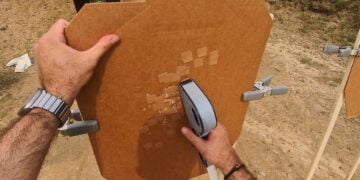A failure to feed (or FTF, jam, whatever you want to call it) can happen, as guns are machines and all machines have an error rate.
However, we’re going to do something a little different here.
Rather than just explain what causes failures to feed, I’ll tell you about a failure to feed that I experienced recently. The issue was more than a one-off (it keeps happening), so it needs to be diagnosed and fixed.
We’re going to go over what happened, and what the potential causes are. The goal here is to hopefully educate newbies on the different parts of a gun that can fail or cause a problem, and also how to run them down. If you drive, it’s a good idea to know a bit about cars – if it doesn’t start, do you know how to tell if it’s the starter or the battery? – and it’s a good idea to understand how guns work if you’re going to have them.
If this post does well enough, I’ll follow up with a “post-op” report on whether I get the problem licked.
The Failure To Feed
The problem I had is a nose-up failure to feed. Failures to feed are when a bullet doesn’t seat in the chamber correctly as the slide goes into battery. If it happens to you, you’ll notice the nose of the bullet is either pointing up or pointing down. In my case, the nose is pointing up.
Something is either pushing the nose of the bullet up or pushing the rim of the case down. This causes the bullet to enter the throat of the chamber at the wrong angle.
The gun in question is a TriStar (Canik) C-100, a CZ 75 Compact clone. I’ve shot a few TriStars before owning this gun, and I know them to be exceedingly reliable and accurate. I can’t find any reports of this happening to anyone else in owner’s forums, social media and so on. Mine, however, does have a hiccup apparently.
This didn’t happen at the range; it happened after I cleaned, lubricated and reloaded my pistol with carry ammunition, which is 124-grain 9mm Federal HST. I inserted the magazine, and it seated perfectly. I pulled the slide back and released it, whereupon the slide stopped due to the nose-up jam. Incidentally, I’m carrying my backup (which doesn’t have this problem) for the time being.
I unloaded the pistol and repeated the action to see if it happened again, which sure enough it did. So, what exactly is causing it?
Causes Of A Handgun Jam
 What can cause a malfunction? Here are some common causes. After this, we’ll run down what the problem with my gun probably is.
What can cause a malfunction? Here are some common causes. After this, we’ll run down what the problem with my gun probably is.
Limp-wristing is a potential cause, but this was from manually cycling the slide, so that’s not it.
Insufficient cleaning and lubrication is also a common cause but wasn’t in this case. The gun was freshly cleaned and well-oiled.
The magazine causes most pistol malfunctions. The issue repeats with both magazines, and the manufacturer uses magazines made by MecGar. Usually, it’s down to bent feed lips, a burr or other problem with the follower, or a bad magazine spring.
Another prime candidate is a feed ramp or chamber throat that needs polishing.
Recoil springs are the next usual suspect. Failures to feed are almost always caused by magazines, feed ramps, and bad recoil springs. Too much tension and it returns too fast; too little tension causes excessive dwell time during the recoil cycle, and the slide doesn’t return fast enough to fully chamber the round.
Another potential cause is the extractor. If the extractor is bent, even slightly, it can produce too much or too little tension which can impede feeding.
The gun in question is hammer-fired. In hammer-fired pistols, the hammer block can cause misfeeds if insufficiently lubricated or if it has any burrs or otherwise needs polishing. This can also indicate a pistol that needs more break-in.
Another possible issue is the ammunition itself. Some guns don’t feed some ammunition well. While 9x19mm ammunition is broadly the same in many respects, there are some variations between brands in terms of overall bullet length (lighter grain weight loads can be shorter though only by a millimeter) and bullet design.
The geometry of a specific gun’s feed ramp can result in some brands/designs of bullets not feeding well due to the shape of the projectile but others feeding just fine. Metallurgy varies by manufacturers too; some brass may be rougher than others, and so on.
So, how to tell what’s causing my gun to go wrong?
Paging Dr. Occam
Cleaning/lubrication can be ruled out, as the gun was freshly cleaned and lubricated. The feed ramp is also not the problem, as I couldn’t detect any burrs or gouges of any kind; it’s glass-smooth. The extractor doesn’t appear to be the problem, either.
I ordered a replacement recoil spring as a matter of course, so we’ll see what that does once it arrives.
The pistol is new, with only a couple hundred rounds through it so far. Insufficient break-in may well be the case, so a trip to the range is going to in my immediate future.
As to the magazines, the issue occurs with both magazines. The feed lips are in good order, and the followers lack any detectable burrs or defects. Also, since the issue happens with both magazines, and the gun is new, that would mean two bad MecGar magazines in a row. While not outside the realm of possibility, I’m fairly certain this isn’t it.
I haven’t shot much HST through it, but it fed other ammunition types without issue. Other TriStar/Canik pistols I’ve shot haven’t had any problem feeding JHP, though I don’t recall shooting HST through them.
My guess? I think it needs a bit more shooting for break-in and doesn’t like HST. Maybe the new spring will do the trick when it shows up. If I do a follow-up to this (depends on you readers!) I’ll include a range report.










